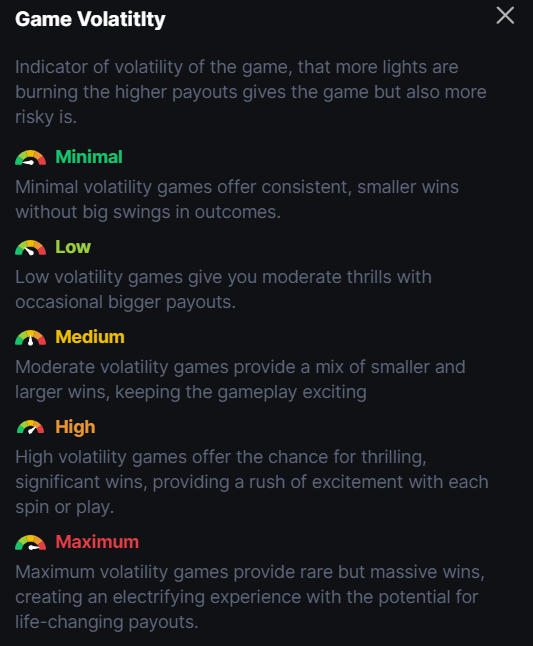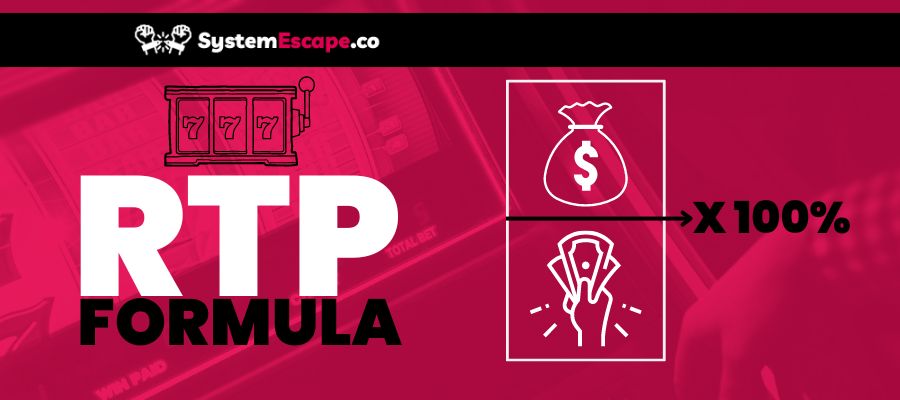RTP in Slots Contents
If you’re curious about RTP in slots, this guide has you covered. We’ll break down everything you need to know about Return-to-Player (RTP), from its definition to how it impacts your gameplay.
Here’s what we’ll explore…
+ What RTP means in slots
+ How to calculate RTP
+ Winning frequency vs. RTP
+ Variance vs. RTP
+ Online vs. land-based slots RTP
+ Variable RTP
+ RTP myths debunked
+ Top slots to play
Let’s get started!
What Does RTP Mean in Gambling?
RTP, or Return to Player Percentage, is the amount of money a slot is expected to pay back to players over time. Imagine a slot with a 95% RTP. Theoretically, for every €100 wagered, the slot would return €95 to players.
This percentage is a key indicator of how much you might expect to lose or win over the long term. It’s calculated by dividing the total winnings by the total amount wagered.
Example of RTP in Slots
If a slot generates €970,000 in wins from €1,000,000 wagered over a month, the RTP would be 97%.
Imagine a slot machine is a giant piggy bank. People put money in (that’s the wager), and sometimes it spits money back out (those are the wins). The RTP is like a rule the piggy bank has to follow: over a long time, it has to give back a certain percentage of what was put in.
In our example, the piggy bank (slot machine) had €1,000,000 put into it over a month. It gave back €970,000 in wins.
To figure out the RTP, we do some math:
Divide the wins by the total money put in: €970,000 / €1,000,000 = 0.97
Multiply by 100 to turn it into a percentage: 0.97 x 100 = 97%
So, the RTP of this slot is 97%. This means that on average, for every €100 someone puts into the machine, they’ll get €97 back over a long period.
But here’s the trick: It doesn’t mean you will win €97 every time you put in €100. Sometimes you’ll win more, sometimes less, sometimes nothing at all. The RTP is just an average over a very long time (think millions of spins!).
Why does RTP matter?
The higher the RTP, the more generous the slot machine is to players overall. A 97% RTP is pretty good, while something like 85% would be much less player-friendly.
Think of it like this: Would you rather have a piggy bank that gives you back most of your money, or one that keeps a lot more of it? The same goes for slot machines – higher RTP is better for the player!
Remember
The higher the RTP, the better your potential returns.

Is There a Correlation Between Winning Frequency and RTP?
RTP and winning frequency are two distinct concepts. Winning frequency measures how often a winning combination appears, while RTP indicates how much of the total wagered money is returned over time.
For instance, a slot with a 10% hit frequency means you could expect to land a winning combination 10 times out of 100 spins. This information is often found in the game’s paytable but is usually a general figure, not exact statistics.
Variance & RTP: What’s the Difference?
Variance, or volatility, describes how a slot behaves regarding win size and frequency. Low variance slots offer smaller, more frequent wins, while high variance slots have less frequent but potentially larger payouts.
Land-Based vs. Online Slots RTP
Online slots typically have higher RTPs than land-based counterparts. Online casinos are transparent about their RTPs, usually displaying them in the game menu. Land-based casinos, however, may not be as forthcoming.
RTP Winning Frequency Analogy
Imagine you have two gumball machines
Gumball Machine A
This one gives you a gumball almost every time you turn the crank. But the gumballs are pretty small.
Gumball Machine B
This one doesn’t give you a gumball very often. But when it does, it’s a giant, super-sized gumball!
These gumball machines are like slot machines.
Winning Frequency
Winning frequency is like how often the machine gives you a gumball. Machine A has a high winning frequency (lots of gumballs!), while Machine B has a low winning frequency (not many gumballs).
RTP (Return to Player) is like how much of your money you get back in gumballs over time. Both machines might cost the same amount to play, but if Machine A has a higher RTP, it means you’ll get more gumballs for your money over lots and lots of turns.
So, even though Machine A gives out gumballs more often, Machine B might actually give you a better deal overall because you might get a few huge gumballs that are worth more than all the little ones from Machine A combined.
Variance is like the difference between the smallest and largest gumballs a machine can give out. Machine B has high variance (small gumballs and giant ones!), while Machine A has low variance (all gumballs are about the same size).
One more thing
Think of online slots as the gumball machines in a candy store. They have big signs telling you how many gumballs you can expect back on average (that’s the RTP).
Land-based slots are like the gumball machines at the laundromat. They don’t always have signs, so it’s harder to know if you’re getting a good deal or not.
Separating Fact from Fiction
RTP Myths & Truths
Understanding RTP is crucial for making informed decisions when playing slots, but there’s a lot of misinformation out there. Let’s clear up some common myths and reveal the truths about slot RTPs:
Myth 1
Online slots are less fair than land-based ones.
Truth
Both online and land-based slots rely on Random Number Generators (RNGs) to ensure each spin is completely random and fair. Additionally, both types of slots have RTPs, which are regulated to ensure they are within legal limits. In fact, online slots often have higher RTPs than their land-based counterparts, giving you a better chance of winning back your money over time.
Myth 2
All slots pay out the same.
Truth
Each slot game has its unique RTP, determined by the game developer and sometimes adjusted by the casino. This means some slots are more generous than others. Always check the game’s information or paytable to find the RTP before playing.
Myth 3
Casinos hide high RTP slots.
Truth
While some land-based casinos might not prominently display RTP information, most reputable online casinos do. It’s in their best interest to be transparent, as players are more likely to choose games with higher RTPs.
Myth 4
RTP doesn’t matter in a single session.
Truth
RTP is a long-term average. In a single session, anything can happen—you could win big or lose everything. However, over many spins, a slot’s RTP will start to show its true colors. Choosing a higher RTP slot increases your chances of winning back more money in the long run.
Bonus Tips for Understanding RTP
Progressive jackpots
These slots have a portion of each bet contributing to a growing jackpot. This can slightly lower the base RTP, but the potential for a massive win makes them attractive to many players.
Volatility
High volatility slots pay out less often but offer larger prizes, while low volatility slots pay out more frequently but with smaller wins. Consider your risk tolerance when choosing a slot.
Bonus features
Some slots have bonus rounds or free spins that can significantly impact the overall RTP. Pay attention to these features and how they affect your potential winnings.
By understanding the truths about RTP and dispelling common myths, you can make more informed decisions about which slots to play and increase your chances of having a fun and rewarding experience.
Final Thoughts
RTP, or Return to Player, is your compass in the world of slots. It’s a crucial factor in determining your potential winnings over time, acting as a guide to the games that are most likely to reward your gameplay.
While a higher RTP doesn’t guarantee a win on every spin, it significantly boosts your chances of coming out ahead in the long run.
It’s like choosing a path with fewer obstacles – you might still encounter a few bumps, but the overall journey is smoother and more rewarding.
However, RTP isn’t the only factor to consider. Volatility, also known as variance, plays a role in determining the frequency and size of your wins.
Low volatility slots offer smaller, more frequent payouts, while high volatility slots deliver less frequent but potentially larger wins. It’s essential to find a balance that suits your risk tolerance and playing style.
Here’s a quick recap of key points to keep in mind
Prioritize RTP
Look for slots with higher RTPs (ideally above 96%) to maximize your potential returns.
Factor in Volatility
Choose a volatility level that aligns with your risk appetite and desired gaming experience.
Research and Compare: Utilize online resources and guides to compare RTPs and volatilities across different slots.
Manage Your Bankroll
Set a budget and stick to it, regardless of the RTP. Responsible gambling is key to long-term enjoyment.
Now that you’re armed with knowledge about RTP, volatility, and responsible gambling, it’s time to put it into practice. Explore our extensive collection of slot guides, tutorials, and tips to discover the best slots that suit your preferences and maximize your chances of winning.
Remember, informed players are empowered players, and understanding RTP is a crucial step towards becoming a savvier slot enthusiast.
A Note on Responsible Gambling
I’m being deadly serious here. Gambling should always be approached with caution and within your means. While it can be a fun and entertaining activity, it’s important to remember that it carries inherent risks.
Tips for gambling responsibly
Set a budget and stick to it
Decide how much money you’re comfortable spending before you start playing, and don’t go beyond that limit.
Never chase losses
If you’re on a losing streak, don’t try to win back your money by betting more. This can lead to a downward spiral.
Take breaks
Gambling can be addictive, so it’s important to take regular breaks to avoid getting carried away.
Don’t gamble under the influence
Alcohol and drugs can impair your judgment and lead to reckless betting.
Seek help if you need it
If you feel like you’re losing control of your gambling habits, don’t hesitate to seek help from a professional organization or support group.
Remember, gambling should be a form of entertainment, not a way to make money. Always play responsibly and prioritize your well-being.
RTP in Slots FAQ
RTP stands for Return to Player. It’s a percentage that indicates how much money a slot machine is expected to pay back to players over a long period of time. For example, a slot with a 96% RTP theoretically returns €96 for every €100 wagered.
RTP is calculated by dividing the total amount won by players by the total amount wagered over a very long period, typically millions of spins.
No. RTP is a theoretical average over a massive number of spins. In the short term, you can win or lose much more or less than the RTP suggests. However, over time, a slot with a higher RTP will generally return more money to players than one with a lower RTP.
A good RTP for an online slot is typically 96% or higher. Anything below 94% is considered low.
No. Each slot game has its own unique RTP, set by the game provider and sometimes adjusted by the online casino.
Online casinos usually display the RTP within the game information or paytable. For land-based casinos, this information might not be readily available, but you can often find it online through the game provider’s website or other resources.
RTP is the average return over time, while volatility (also known as variance) indicates the risk level of a slot. High volatility slots pay out less often but offer larger prizes, while low volatility slots pay out more frequently but with smaller wins.
Progressive jackpot slots have a portion of each bet contributing to a growing jackpot. This can slightly lower the base RTP, but the potential for a massive win makes them attractive to many players.
Choose slots with higher RTPs to increase your potential returns over time. However, remember that RTP is just one factor. Volatility, your budget, and responsible gambling practices also play significant roles in your overall slot experience.
















